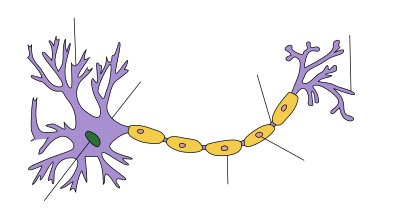Axon terminal
| Neuron |
|---|
Axon terminals (also called synaptic boutons) are distal terminations of the branches of an axon. An axon nerve fiber is a long, slender projection of a nerve cell, or neuron, that conducts electrical impulses (called "action potentials") away from the neuron's cell body, or soma, in order to transmit those impulses to other neurons.
Neurons are interconnected in complex arrangements, and use electrochemical signals and neurotransmitter chemicals to transmit impulses from one neuron to the next; axon terminals are separated from neighboring neurons by a small gap called a synapse, across which impulses are sent. The axon terminal, and the neuron from which it comes, is sometimes referred to as the "presynaptic" neuron.
Neurotransmitters are packaged into synaptic vesicles that cluster beneath the axon terminal membrane on the presynaptic side of a synapse. The axonal terminals are specialized to release the electrical impulse of the presynaptic cell. The terminals release transmitter substances into a gap called the synaptic cleft between the terminals and the dendrites of the next neuron. The information is received by the dendrite receptors of the postsynaptic cell that are connected to it. Neurons don't touch each other, but communicate across the synapse.
The neurotransmitter molecule packages (vesicles) are created within the neuron, then travel down the axon to the distal axon terminal where they sit docked. Calcium ions then trigger a biochemical cascade which results in vesicles fusing with the presynaptic membrane and releasing their contents to the synaptic cleft within 180 µs of calcium entry. Triggered by the binding of the calcium ions, the synaptic vesicle proteins begin to move apart, resulting in the creation of a fusion pore. The presence of the pore allows for the release of neurotransmitter into the synaptic cleft. The process occurring at the axon terminal is exocytosis, which a cell uses to exude secretory vesicles out of the cell membrane. These membrane-bound vesicles contain soluble proteins to be secreted to the extracellular environment, as well as membrane proteins and lipids that are sent to become components of the cell membrane. Exocytosis in neuronal chemical synapses is Ca2+ triggered and serves interneuronal signalling.
...
Wikipedia

